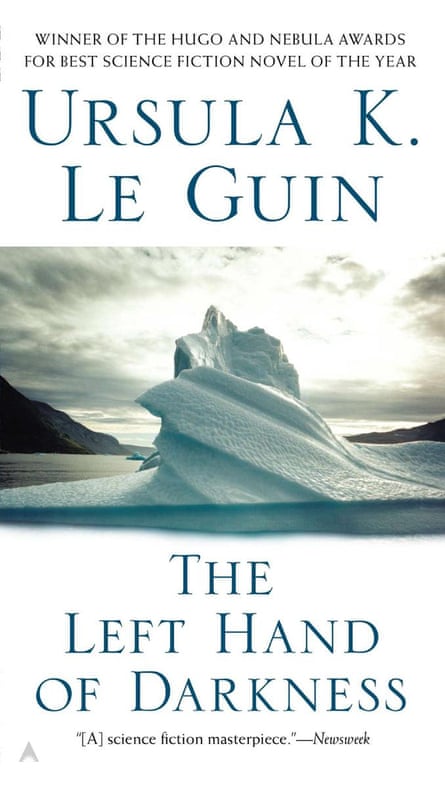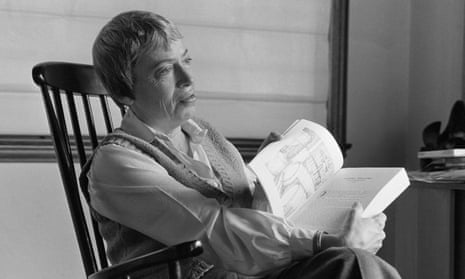The writer Ursula K Le Guin, who has died aged 88, presided over American science fiction for nearly half a century. Her reputation as an author of the first rank, and her role as ambassador for the genres of the fantastic, began in 1968 with her fourth novel, A Wizard of Earthsea. It has not been out of print since.
A few months later, Le Guin published The Left Hand of Darkness (1969), which won both the Hugo and the Nebula awards for its year, and which soon became the novel most heavily taught in universities during the first flourishing of scholarly interest in science fiction as a form of writing peculiarly well adapted to make arguments about the changing world. The book, a quietly revolutionary study in gender, has become a central feminist text.

A Wizard of Earthsea is a young-adult fantasy tale set on an archipelago scattered across a translucent world-ocean, each individual island peopled with men, women and children whose lives, though necessarily shaken by dramas, seem mysteriously exemplary. But there is no preaching, beyond an abiding sense that a good life can only be achieved through prayerful attention to just balance; the influence of Carl Jung, and of Le Guin’s elsewhere explicit interest in the principles of Taoism, are here unspoken. The book created, in the increasing number of readers who discovered it, a longing to be there. The effect of the series as a whole has been likened to that of CS Lewis’s Narnia books a generation earlier.
In The Left Hand of Darkness an ethnologist from Earth visits Gethen, a distant planet populated by human-like beings whose nature transgresses his earthly frame of biological understanding: for they are androgynous, only electing to become male or female at the height of their sexual cycle. The ethnologist’s trek across the snowbound planet with a native of Gethen gives some deep lessons about our parochial understanding of the nature of gender. The balanced incisiveness of the tale seems almost anthropological, though infused with story.
Perhaps the most intellectually formidable of Le Guin’s attempts to embed into fiction her speculations about human nature and nurture is The Dispossessed: An Ambiguous Utopia (1974). It also won Hugo and Nebula awards, the only time an author has gained both awards more than once for single titles. Like The Left Hand of Darkness, it has become a staple of university courses, though this time its influence has been stronger in the field of utopian studies.
The science-fiction toolkit is hugely useful in the tale, allowing Le Guin to embed her two contrasting utopian worlds – the increasingly rigid, anarchist Anarres, and the wealthy but hierarchical Urras. Anarres is in fact Urras’s moon; the physicist protagonist leaves Anarres, where fellow-thinking has evolved into something like thought-control, and in the rich vastness of Urras is able to pursue his theoretical investigations into the nature of the universe; while at the same time comparing and contrasting, as traditional visitors to Utopia do, the societies under his purview. The dryness of any synopsis of The Dispossessed is confounded by the intense readability of the tale.
Le Guin increasingly became a plenipotentiary representative of the genres of the fantastic, which she argued were of central literary importance in the 20th century. The Language of the Night (1979) and Dancing at the End of the World (1989) were the most substantial of her many non-fiction titles, though Lao Tzu: Tao Te Ching (1997) may be more revealing. Throughout, she conveys her strong conviction that science fiction and fantasy, though fascinating in themselves, are also essential literary constructs or tools through which the world could profitably be described – but only if one honoured the tools. She was impatient – though respectfully so – with her friend Margaret Atwood’s disinclination to call some of her own novels science fiction.

That dignity and openness did, in the end, cost Le Guin, though perhaps not heavily. She became something of an icon for those with special interests to pursue, and was constantly on the stand as feminist and gender studies, in particular, matured. A relatively late novel, Always Coming Home (1985), attempts to encompass the changing worlds she was deemed to speak for, though The Word for World is Forest (1976) is a much sharper assault on capitalist exploitation of the natural world.
Ursula was born and raised in Berkeley, California, by what might seem to be the ideal parents to nurture the writing to come. In 1901 her father, Alfred Kroeber, had gained the first PhD to be granted in the US for anthropology, and spent the rest of his long life at the University of California, Berkeley, publishing widely and influentially. Her mother, Theodora (nee Kracaw), was the author of Ishi in Two Worlds (1961), a biography of the “last wild Indian in North America”.
Ursula went to Radcliffe College in Cambridge, Massachusetts, then took a master’s in romance literature of the middle ages and Renaissance at Columbia University, New York, graduating in 1952. She won a Fulbright scholarship to Paris, where she met Charles Le Guin, a history scholar, and they married in 1953. They eventually settled in Portland, Oregon, where Charles taught history at Portland State University.
As one of several promising authors who first began to publish science fiction in 1962, Le Guin was initially outshone by others in a dazzling cohort; they included Samuel R Delany, Thomas M Disch and Roger Zelazny, each of them fluently pyrotechnic stylists, each of them visibly destined for prominence. In this crowd, Le Guin was hardly noticed.
Her first stories, few in number and competent in execution, slid quietly into print; their sure sense of narrative balance, conveyed without rhetorical stagecraft, may have been misunderstood as a failure of energy. Her first novel, Rocannon’s World (1966), a paperback original bundled back-to-back with a muscular tale by the eccentric (and highly visible) Avram Davidson, made a similar impression; and two more tales met much the same fate. Then came A Wizard of Earthsea.
In the 1980s, so wearing was the burden of the attention paid her that Le Guin seemed to withdraw from the frontline. She was writing and publishing stories and poetry during these years, and after 1990 or so markedly increased her flow of longer fiction. But some of the later work suffers from the need she clearly felt to speak responsibly to her large audience about important things; an artist being responsible can be an artist wearing a crown of thorns.
For whatever reason, by the age of 80, Le Guin had had enough of fiction. She continued to publish incisive reviews and other prose works, edited and translated Spanish fantastika, and wrote poetry. A collection of essays entitled Words Are My Matter: Writings About Life and Books, 2000–2016, won a 2017 Hugo award, and a documentary by Arwen Curry, which compiles hours of interviews with the writer, Worlds of Ursula K Le Guin, is in production.
In person, Le Guin had always had a lean, frighteningly attentive demeanour. In old age, her face seemed carved with wisdom. She had become the mother of her tribe.
Charles survives her, along with their three children, Elisabeth, Caroline and Theodore, and four grandchildren.

Comments (…)
Sign in or create your Guardian account to join the discussion